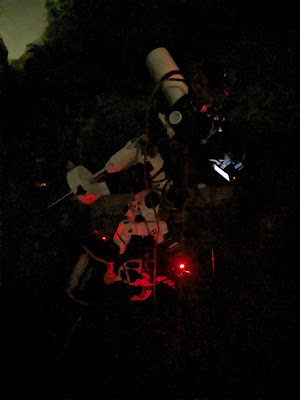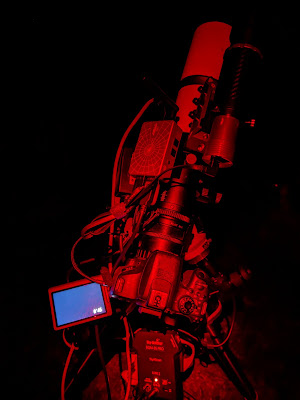First visit to this astronomy/astrophotography blog? Well, firstly a warm welcome to you and thanks for stopping by. After reading this post, if you want to find out more about me and this blog, why not visit my introductory page at https://undersouthwestskies.blogspot.com/2025/01/welcome-to-my-new-astronomyastrophotogr.html You can also browse other posts by using the search bar or the blog post list on the right hand side and I'd really like to hear from you via the comment boxes. Drop me a tip, an observation or a question. Take care and clear skies to you. Steve
Globular clusters, the ancient stellar cities of the universe, formed just after 'The Big Bang'. I can't remember where I read this but I was instantly hooked!
They are beautiful objects to photograph and observe. highly packed spherical agglomerations of stars, circular or oval in shape, they can look like spilt sugar on a black cotton table cloth; not that I have been many places where black tablecloths were de-rigours.
William Herschel used the name 'globular' first - from the latin globulus meaning small sphere apparently. The immense density of stars within globular clusters means that they remain bound together irrespective of whatever gravitational disturbances from the milky way or gaseous drag is occuring in the immediate galactic neighbourhood. This brightness and density means that globular clusters have a high surface brightness and so some can be easily seen through binoculars and small refractor scopes, even during moonlit nights!
Reading an article in an astronomy magazine recently, (I can't remember which one but it would have been either Astronomy Now or The Sky at Night - the only two I tend to read when I can), that globular clusters can be classified - The Shapley-Sawyer Concentration Class - a 12 step classification of the relative density of the core. I = high concentration of stars. XII = almost no concentration towards the centre!
I have been focused in recent weeks on imaging M13 in Hercules. 25,000 light years away, at a magnitude +5.8, if you are in a truly dark site like the Elan Valley, you have a good chance of seeing it with the naked eye on a moonless night. Edmond Halley who discovered it in 1714 said "this is but a little patch, but it shows itself to the naked eye when the sky is serene and the Moon absent".
How can you find M13?
M13 sits just outside the largest edge of the keystone asterism in the constellation Hercules. Use the stars Vega and Arcturus to lead your viewpoint to this keystone star pattern - a large uneven square of four stars, found about a third of the way from Vega to Arcturus. M13 will be a third of the way along the longest edge of the square between the stars Eta Herculis and Zeta Herculis.
What equipment have I been using to image M13?
- Zenithstar 61ii with field flattener
- Canon 800D astro-modded DSLR
- ASIair mini
- ZWO 120mm mini guide cam
- RVO 32mm guide scope
- EQM-35-Pro mount and tripod
- Celestron Lithium Pro power tank
- small power bank to power dummy battery for DSLR
What are my 'beginner tips' for shooting globular clusters?
The great thing about globular clusters are they make decent targets for astrophotography during moonlit nights. We are aiming for the following:
- sharp images with pinpoint stars
- a good halo of stars around the core
- no blown out stars or oversaturated ones
- no blown out core
I did some reading before hand and most tips I found stressed the following. Firstly, and counterintuitively, keep your exposures low. Go for shorter exposures but more of them to get the integration time. Several people recommended bracketing shots at different ISO's first; followed by taking exposures at 10, 15, 20, 25 and 30". Compare the results and pick what best works for you and your shooting conditions.
Secondly, pay real attention to your FWHM settings! Yikes - my what? Your Full Width, Half Measure. I had to do some reading around this subject! Essentially, at its simplest, if I understand this correctly (how many caveats can I put in here) - FWHM is to do star focus quality. A star has a bell shaped profile. Using a bahtinov mask and the guiding software of your choice, you are aiming to get your stars as sharp as possible - the lowest FWHM. Basically, the lower the star value - the more focused it is.
Stressful reading was that!
So what settings were recommended? Well, how long is a piece of string?
I've put the settings I used below the two images I have taken thus far and we can do a comparison in a minute. Many on astrobin, cloudy nights and stargazers lounge (if you haven't come across these forums, look them up because I cannot recommend membership of them too highly for beginners to astronomy and astrophotography - members are so knowledgeable and generous with their advice), suggested starting with 30" and an ISO of 800. Most agreed that in terms of integration time, 45 - 90 minutes would be plenty enough. many also suggested using a delay between each of your images of around 8 - 12" to allow your sensor to cool. This will help reduce the noise in the final stacked image apparently.
So, there we are. Some beginner tips for imaging globular clusters. Here are my first images:
These two images are the same data but processed slightly differently. I'll do another post on how I processed them in SIRIL when I better understand what it is I am doing
The acquisition data for the photos is as follows:
From my back garden with moon at 35% in a Bortle 4 area
ISO 800, 120" x 30
You can see how that too long an acquisition time has resulted in the core being blown out!
For my first effort at a globular cluster, I'm quite pleased with these. Not bad, not bad at all but plenty of room for improvement.
So, what is my post editing workflow for the above images?
Firstly, I used SIRIL, GraXpert and Affinity Photo.
My aims: to enhance the colours and contrast; to manage star appearance.
Here is my workflow. Remember, I am a beginner like many of you and I am still getting to grips with these editing programs. I am using siril version 1.2.6
- Stacking of Lights and calibration frames in SIRIL to gain results file
- Siril - open results file - select 'histogram' on bottom menu - right click on image and CROP. Save as resultscrop.fits
Next open this resultscrop.fits file in GraXpert
- background extraction (at 15% in bottom menu and smoothing at 1.0 using AI
- save as 32 bit fits file resultscropBge or some such name
Return to SIRIL and open this new image
- image processing - star processing - click on cog icon
- now click on stars icon - tick amplitude box - enter new values into amplitude boxes (I use 0.1 to 0.7)
- click star icon - a list of stars should appear in the dialogue box - keep this box open - drag it to one side
- image processing (top menu) - deconvolution - PSF from stars - generate
- In the PSF box - the star should be within the box with black space around it - if the star is going outside the box alter the PSF values by increasing them - keep generating and altering the values until the star generated fits within the box with black around it.
- Close the PSF box that you dragged to one side
- On remaining dialogue box open (the deconvolution box), experiment with the iterations gradient settings - and when happy - click apply
- image processing - colour calibration - PCC
- image processing - green noise removal
- image processing - star processing - starnet++ removal
- load the starmask result image (for globular clusters ignore the starless image that has been generated - we don't need it)
Move back to GraXpert
- open new image - the starmsk image just generated in SIRIL
- now complete a denoise (using AI)
- save as 32 bits fits file
Return to SIRIL and open the denoised image
- Check that you have image in Linear mode on bottom menu.
- image processing - GHS histogram stretch - take the local stretch intensity slider across to max
- use mouse to zoom closer into the cluster on the image
- now move stretch factor slider on GHS box across to right until stars are just appearing - apply
- image processing - GHS histogram stretch 2 - Local intensity stretch slider 2/3rds way across to right - now apply tin amount of stretch slider - zoom into image to look for artifacts in surrounding stars - move slider back to eliminate these - ensure not blowing out the globular cluster core - click apply when happy
- you can apply a saturation stretch now - top right hand corner menu on this second GHS histogram dialogue box). Do very tiny adjustments to saturation
- save as tiff file if opening in affinity photo
Now load up the above completed image into affinity photo
- I open the image in camera raw editor and then make subtle edits. be prepared to mask the core so you can work on the background first; and then the reverse, masking the background to work on the core
I hope this helps you get started if you are still getting to grips with SIRIL like me. Let me know if you have better tips for editing globular clusters. Share them in the comment box below so that we can all learn and grow further together.
As always, have fun, stay safe out there and clear skies
Steve
PS:
Here is my latest GC image - M92
The same image data. The image above is a cropped in version of the image below
Processing data: SIRIL, GraXpert and Affinity Photo - as described above
Capture data: ISO 800, 30" x 120 (One hour integration) and 20 of each calibration frame.
Moon at 93% full. Bortle 4 skies
Equipment used: Canon 800D, Zenithstar 61ii, EQM-35-Pro, ASIair mini, ZWO 120mm mini guide cam with RVO F/4 32mm guide scope
Another globular cluster from the constellation Hercules. Magnitude +6.44, it was discovered by Johann Bode in 1777 and was then independently rediscovered and catalogued by Charles Messier in 1781. 26,000 light years away, it is smaller and fainter than its neighbour M13. Its true diameter is around 100 light years with a luminosity of 150,000 sun's; nothing to worry about but it is approaching us at around 112 km/sec.
M92 is believed to be exceptionally old, around 14 bn years, almost as old as the Universe itself. It contains around 300,000 stars and the predominant elements within it all are helium and hydrogen. Hence it is a metal poor cluster.
A fun factoid - here we go - the north celestial pole will come within a degree of M92 in about 14,000 years time. Every 26,000 years the Earth completes a precession of its axis and during this cycle, the pole moves closer to M92. M92 was last a pole cluster back in 10,000 BC.
Anyway, back to my processing of the data - its not bad for one hour. I need to sharpen up the images; sharpen up the star edges - I think they are a bit soft. I need to sort out the core as well - its a bit blown out. Perhaps doing some masking to reduce colour saturation of the background as well.
I know WHAT might need doing. Knowing HOW to do it is an entirely different matter. It's hard work this post editing malarkey. I may have said this before?





















